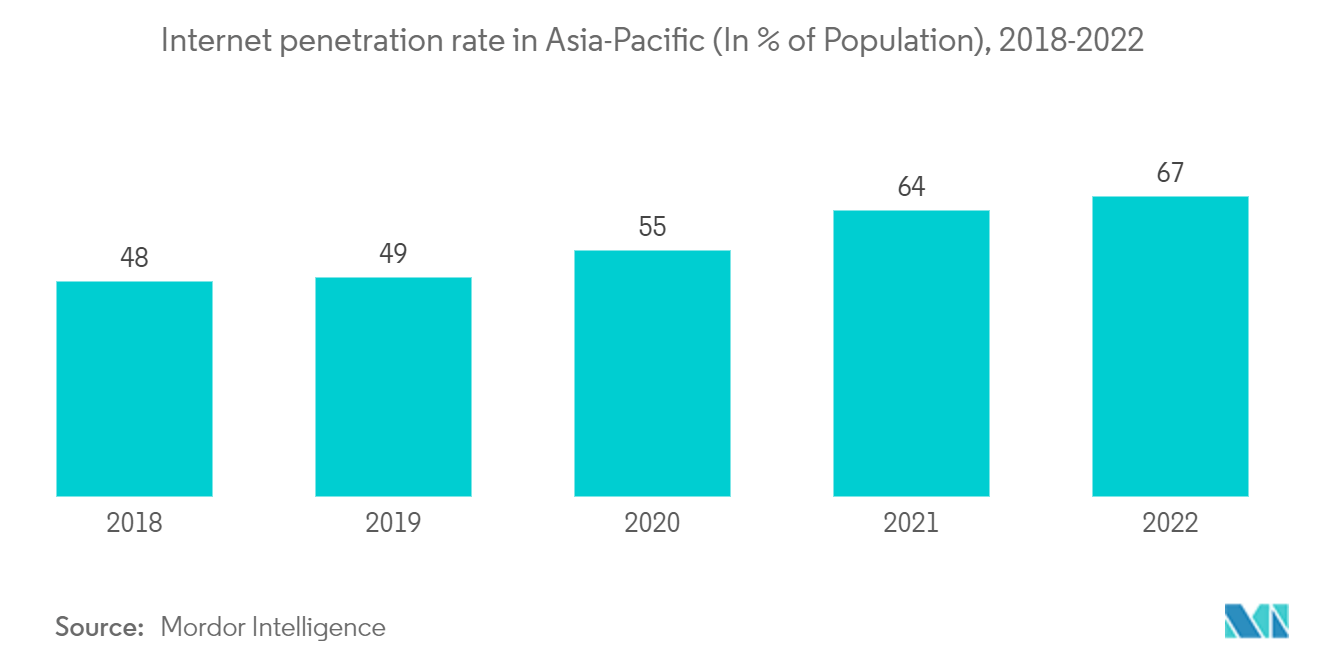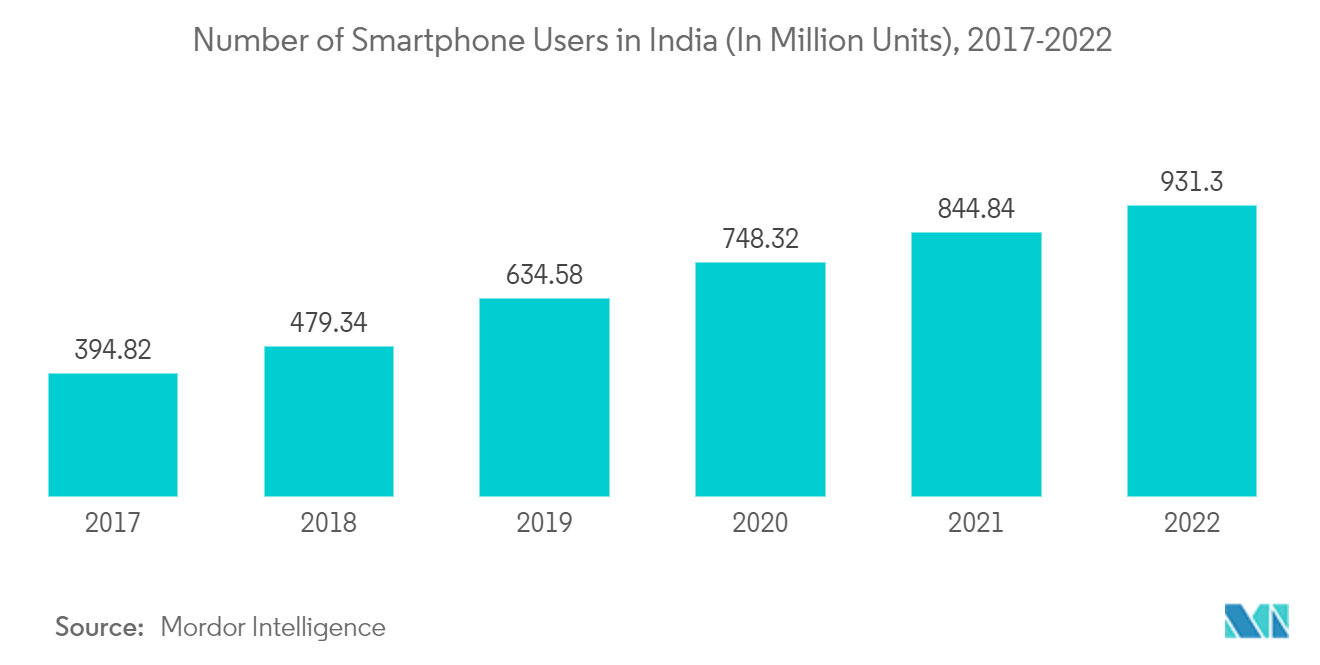Market Trends of APAC Two-Wheeler Taxi Industry
Increase in Smartphone and Internet Penetration Across the Region will Stimulate Pay as You Go Segment
- The demand for two-wheeler taxis is growing, as these are cheaper and faster than cab services. Ease of riding motorcycles in congested traffic, rising middle-class family income, and low charges when compared with cabs are expected to drive the Asia-Pacific taxi market.
- With the growing use of smartphones, the development of wireless infrastructure backed by the presence of 4G services, and the advancements in information and communication technology (ICT), traditional services have been upgraded to provide a wide variety of real-time and demand-responsive trips. Service providers such as Uber, Ola, Grab, and Rapido, amongst others, have provided a smartphone-based platform to link riders with community drivers.
- Internet penetration, the rise in the standards of living, and the emergence of local players are slowly shifting the landscape. Over the forecast period, the rising demand and the market scenario are expected to be graphically different and in favor of on-demand transportation services.
- The two-wheeler mobility landscape is undergoing a dynamic change, with bike taxi space reporting double-digit growth. Bike taxis saw a growth of around 10% on a month-on-month basis in 2021 as compared to 2020. This is because they are much more affordable than cabs and provide easy maneuvering in traffic congestion.
- Technological advancements assist in locating taxis and calculating the estimated time of arrival at the pickup place and destination. These enhancements serve to shorten the time and increase the taxi's availability. As a result, the bike taxi sector is expected to expand in the coming years as most aggregators are providing online services through their smartphone apps. Moreover, as a greater number of digital payment providers are in the market, online taxi booking has made the process hassle-free.
- With growing competition in the market, major bike taxi companies have adopted strategies, such as offering new services across other online platforms. For instance, in December 2021, Uber and WhatsApp announced a new partnership in India, wherein customers will be able to book a cab/bike using the ride-share service's official WhatsApp chatbot. The feature has been built on the WhatsApp Business Platform, where customers will be to carry out all activities via the WhatsApp chatbot, from registration to booking the cab/taxi to trip receipt.
- The above-mentioned development across the region is likely to witness significant growth for the market during the forecast period.

India is expected to lead the Two – Wheeler Taxi Market
- India is the second-most populous country in the world, and most of the people fall under the middle-class category and utilize two-wheelers and auto-rickshaws (local three-wheeler taxis) for commuting short distances. Bike taxis are more affordable than cabs and can zip through congested roads. They are popular among millennials. On average, a bike taxi ride costs INR 60-70 (USD 0.86-USD 1), whereas a cab ride costs INR 150 - 200 (USD 2.14-USD2.86) for the same distance.
- In tier-I towns, two-wheeler taxi services are used frequently for last-mile connectivity. In Gurugram, for instance, one out of every two UberMoto trips begin or end at a metro station; in Noida, the same is true for one out of every four UberMoto trips.
- In spite of concerted efforts to enhance public transportation in urban areas, personal vehicle usage has increased throughout India. The use of paratransit vehicles like bike taxis, which can serve a larger number of commuters than a private vehicle, is encouraged by city administrations. While bike taxis are common in some Indian cities, state laws and policies restrict their use elsewhere in the country. Bike taxis are a cost-effective and convenient mode of transportation that must be encouraged through a regulatory framework that includes safety features and prevents misuse in the face of growing congestion in cities.
- In tier II cities and beyond, bike taxi services are popular because of the lack of public transport infrastructure. With the efforts of the public and private sectors, Thailand is expected to significantly improve energy efficiency in urban transportation. This is likely to witness major growth for the market across the country.
- Bike taxis are common in many Southeast Asian nations, including Cambodia, Thailand, Indonesia, and Vietnam, due to their low prices and quick travel times. In Indonesia, bike taxis, also known as ojek in the local language, are popular because they save time and money in the midst of the massive traffic congestion in the cities.
- Vietnam is another country where two-wheeler taxis are witnessing rapid growth due to the high ownership of two-wheelers. Ho Chi Minh is located in the southern region of Vietnam and is one of the most motorcycle-dependent cities, with 680 motorcycles per 1000 habitats. In 2014, the introduction of Grab brought an exponential increase of 50,000 drivers from 100 drivers. The main users of motorcycle taxis belong to the middle- and low-income level population. Such services are mainly used for medium distances (5-10 km), especially by students and workers.
- In the coming years, in order to meet the growing demand for mobility, a number of major cities have already begun to offer more public transportation options at reasonable prices. Due to their utility in terms of time and cost for certain types of travel, paratransit vehicles like bike taxis may be considered as an additional mode of transportation that gives the urban economy a boost.


